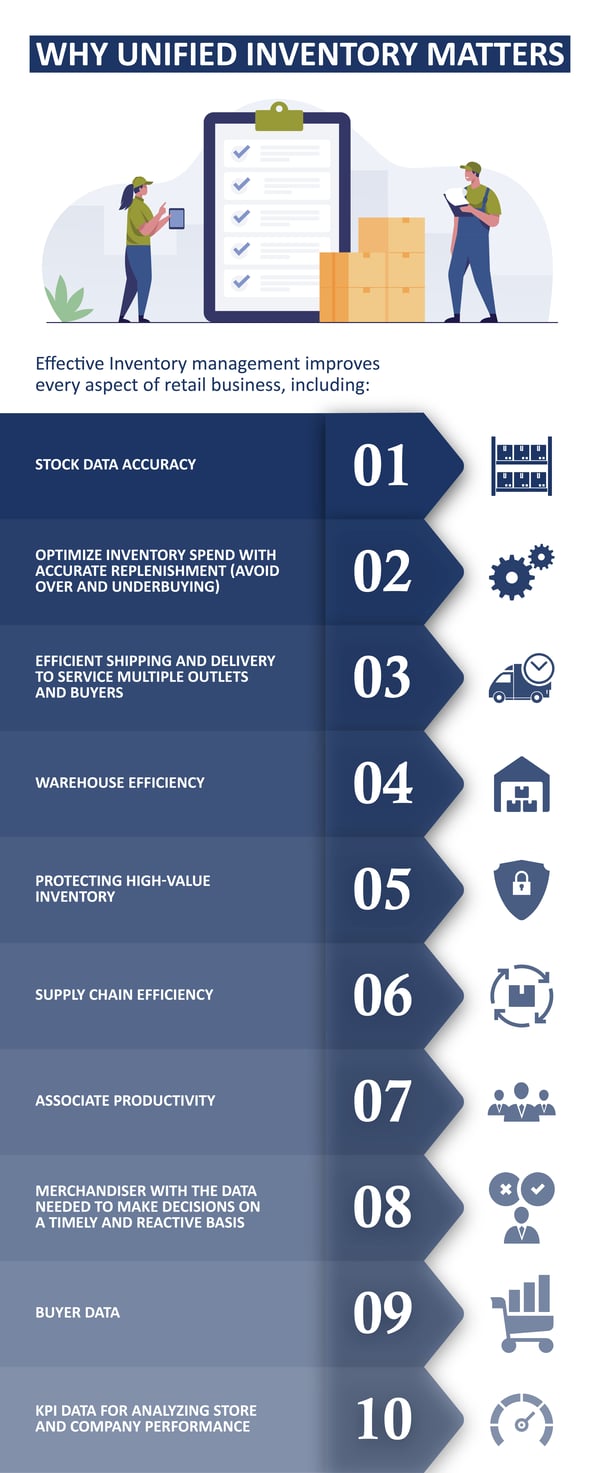What is Inventory Management?
In a nutshell, inventory management is the process of ordering, storing, using, and selling a company’s inventory. In general, this includes the management of raw materials/components, work in progress (WIP), finished products, and products for maintenance repair and overhaul (MRO), as well as warehousing and processing those items. For retailers, inventory is one of the most valuable assets, with finished products the lifeblood of business.
Inventory management is essentially a critical balancing act for retailers of any size. Knowing when to restock inventory, what price to pay for inventory, and when to sell at what price are complex decisions. Insufficient or a shortage of inventory—not having product where and when needed—sabotages sales, sending shoppers to competitors and eroding loyalty. On the other hand, too much inventory can be a liability, falling prey to shifting consumer demand that requires disposal at clearance prices.
The goal of any inventory management system is to support the most effective buy/sell/delivery decisions, which requires real-time information about product volume and location. For small businesses with one or two locations, it may be possible (though certainly not the most efficient way) to keep track of stock and determine reorder points and quantities manually using spreadsheet (Excel) formulas.
For larger retailers with many locations, warehouses and distribution centers, real-time manual tracking is virtually impossible. They typically rely on specialized, possibly highly customized enterprise resource planning (ERP) software. Retailers with ERP software that provides continuously updated accurate counts, should consider choosing as a differentiator a software-as-a-service application (SaaS) that acts as the hub for all real-time buys and sells to unify inventory visibility across a complex landscape.
Key to Retail Survival
Today’s buy-it-now shopper is short on time and patience. Stock-outs drive frustrated buyers to other stores or marketplace sites in search of a hassle-free omnichannel shopping experience that meets their unflinching demand.
To prevent sales losses due to lack of accurate inventory information, access to up-to-the-minute inventory data across the retailer’s ecosystem of stores, warehouses, and distribution centers is critical for answers:
- If an item isn’t in the store, where is it available and how soon can it be delivered to the delivery/pickup location? (ecosystem)
- If an item isn’t on the shelf, is it at receiving, in the stockroom or waiting to be re-shelved? (in store)
- Are items running low being replenished? (stock management)
Modern inventory management technology needs to provide real-time inventory answers to locate, transfer, or ship items in the fastest, most efficient way possible. Next-generation, unified, and powerful inventory and order management functions consume live feeds of transactional data to track every buy, sell, and return for instant access to accurate inventory balances—everywhere. Unifying demand and stock, each store has a simple, continuously updated view of order flow for store fulfillment from web orders. In addition, demand-driven replenishment software ensures stock availability at market and global levels.

Disadvantages of Data Delay
The seemingly unending parade of store closures over the past several years is evidence that without the right mix of products at the right time, retailers perish. It’s simply undeniable that intelligent, real-time, data-driven, and unified inventory management is the fulcrum that balances convenient anywhere shopping (online/mobile/in store) with efficient fulfillment (pickup/delivery).
Insufficient inventory management frequently results in inventory write-offs, which indicates a company’s inability to sell goods. Excessive inventory obsolescence makes it difficult for the retailer to stay competitive when forced to dispose of unsold, aged inventory at steep discounts that don’t cover landed costs.
Another shortcoming falls into the associate’s lap. Without up-to-the-minute inventory information at their fingertips, they are unable to help customers find specific products. By giving access to this critical information and aligning it to a customer’s purchase history, associates can recommend alternative items as well as additional companion products for cross sell and upsell. A win-win.
Inventory management technology that’s easy to learn empowers associates quickly—good news especially for shortening the learning curve for seasonal and part time employees. What’s more, real-time inventory information can help eliminate the need for and expense of costly third-party counting services.
The growing number of returns stemming from exploding e-commerce can’t be ignored. Retailers must find a way to deal more efficiently with return complexity in order to minimize impact on the business. Real-time tracking of these transactions is essential to keep inventory levels honest and avoid unnecessary replenishment that causes overstocks and shrinks margins. Returns data should be immediately available across the omnichannel enterprise also to inform at-the-time business decisions for marketing, promotions, online stores and more.
Inventory management workflow is essential for portraying a true inventory picture, i.e., not until an employee restocks a returned item should it be added to stock balance. The same is true for a returned item that needs to be relabeled for clearance. If a returned item is damaged and goes either to a boneyard section in the back of the store or into an assigned dumpster for perishables and proper removal, it should not be added to inventory.
ERP and inventory management configurations should ensure that items damaged in shipping and at receiving are headed back to the distribution center or vendor and aren’t entered into inventory. When items should go back to the DC or vendor source for store credit, ERP should credit the store and remove those items from the store balance sheet. Workflow should allow for a return merchandise authorization (RMA) order number as well as capturing the original purchase order of return items.
When a delivery is received, the store stock balance may “think” items are available, but in fact were not on the truck. When store associates unload stock from the pallet or boxes that have been left in their department for them to stock shelves, they must reconcile shortages and adjust the actual store balance.

More about how inventory management works.
Adapting Inventory Management Methodologies
Changing global supply chain conditions are forcing retailers to adapt their inventory management methodologies. The well-established Just-in-Time (JIT), Economic Order Quantity (EOQ), and Days Sales of Inventory (DSI) approaches have of late been decimated by unexpected events and trends. Tanker delays at ports near and far, supply shortages, excessive pandemic-driven demands, and social media-driven fads are wreaking havoc with ERP forecasts.
Companies that manufacture and sell their products use different IM methodologies in their plants and distribution centers vs. their retail space. Companies that use multiple vendors to supply their retail space face different challenges like those mentioned.
Inventory management types
When evaluating inventory management solutions, consider:
periodic inventory management
inventory valuation system for financial reporting purposes in which a physical count of the inventory is performed at specific intervals; best suited for smaller businesses that don’t keep too much stock in their inventory. For such businesses, it’s easy to perform a physical inventory count. It’s also far simpler to estimate the cost of goods sold over designated periods of time.
barcode inventory management
A bar code is assigned to and printed on a label attached to each product that is readable by a scanner; a code can reflect supplier, dimensions, weight, location (bin/shelf in a warehouse or stockroom), etc., and be synchronized with the business’ inventory management system; smart barcodes are required for marketplaces such as Amazon and Alibaba.
RFID inventory management:
RFID tags allow readers to read product data; stock control software uses radio waves to communicate with and write data to the tag for real-time updating in place.
Manual inventory management:
inventory is updated, maintained and controlled by physically counting the inventory items on a frequent basis—a labor-intensive, error-prone exercise.
perpetual inventory management:
Records the sale or purchase of inventory immediately through the use of a computerized point-of-sale (POS) system and enterprise asset management software; detailed view of changes in inventory with immediate reporting of the amount of inventory in stock, accurately reflecting the level of goods on hand; supports EOQ calculation for automated replenishment. Read about how a powerful inventory and order management system tracks every transaction and maintains accurate inventory balances everywhere.

How to Improve Inventory Management
The top three steps to take (and most obvious) for optimizing inventory management is to automate, automate, automate. Eliminate data lag by replacing manual processes with an investment in software that will deliver game-changing ROI across your entire retail operation as noted previously.
Easy-to-use software with customizable views will let you know at a glance what inventory is churning and what isn’t to assist buyers and inform pricing decisions. In addition, you’ll see how customer demand is changing and gain insight into emerging trends to inform planning.
Glossary of Inventory Management Terms
Below is a list of frequently used inventory management terms for handy reference:
- stocktake policies: how and when a business manually checks and records all inventory it currently has on hand that impacts inventory control, purchasing/production and sales.
- stock-out management: plan to prevent customer orders from exceeding in-stock inventory and safety stock thresholds; supply chain issues, including vendor production shutdowns, need to be considered.
- stagnant stock management: process for handling dead inventory or obsolete items that aren’t expected to sell and need to be moved out to make room for new stock.
- agile stock keeping: ability to move inventory within a retail ecosystem to where items are in higher demand.
- sell-through rate: calculation, commonly a percentage over one month, that compares the amount of inventory a retailer receives from a manufacturer or supplier against what is actually sold to the customer; highlights trends.
- age management: tracking inventory age and handling inventory that reaches its threshold and remains unsold (six months or more), such as discounting.
- abc classification: a method of classifying inventory items depending on use and value.
- age reserve planning: the determination of how to handle aging inventory, including specific time frames, specific items, and methods.
- safety stock planning: determining the amount of inventory that should be added to the average lead time demand for accommodating random increases in demand, minimizing the risk of stockouts, lost sales, and backorders.
- supply/demand planning: the process of forecasting demand for a product so it can be produced and delivered more efficiently and to satisfy customers; based on a statistical forecast that considers influential factors, such as inventory and marketing, and specifies where to distribute products to meet the anticipated demand.
- integrated business planning: process for aligning a company’s business goals with its finance, supply chain, product development, marketing, and other operational functions; done so materials are bought at the right price, at the right time and in the right quantity to fulfill market demand.
- stocktaking: periodic scrutiny to get the difference between actual and recorded stock levels such as annual physical counting for tax purposes and weekly cycle counting for restocking.
- SKU (stock keeping unit): system of identifying stock units in which a unique number is used to internally track a business’ inventory.
- batch tracking: tracking inventory items received on a specified date for a specified cost; provides basis for valuation methods that use the LIFO or FIFO valuation methods.
- landed cost: total amount of money it costs the retailer to get product from the manufacturer to the end customer, including shipment, insurance, taxes, and duties.
- demand forecasting: predicting amounts/volumes of goods customers want.
- safety stock: a set of inventory/items kept for handling unexpected circumstances.
- FIFO and LIFO: first-in-first-out and last-in-first-out stock valuing conventions.
Key Takeaways
As you take steps toward efficient inventory management, keep in mind the following points:
- Customer loyalty thrives on inventory availability and keeping delivery commitments.
- Real-time data is a must for locating, transferring, and shipping items in the fastest, most efficient way possible.
- Demand-driven, configurable rules-based replenishment ensures stock availability at all points across the retail ecosystem, allowing for supply-chain volatility.
- Up-to-the-minute views of order flow should be accessible to each store for web order fulfillment.
- Associate and buyer efficiency and effective management decision-making hinge on access to real-time data.
- Store performance should be available at any given time.
- Unifying inventory and order flow data is the key to empowering sales and delighting customers.
More information about OneView’s Inventory Management and its retail accelerators for delivering true unified commerce risk-free is available here.

